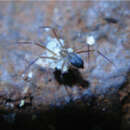en
names in breadcrumbs


The spider family Ochyroceratidae includes 161 described species (Platnick 2013). This is a tropical family of six-eyed spiders, but two species have been recorded as far north as southern Florida (U.S.A.) (Paquin and Ubick 2005). Although some ochyroceratids are associated with caves, the majority of species occur in forest litter, where they spin small irregular webs or finely mazed sheet webs (Deeleman-Reinhold 1995). In the tropics, ochyroceratids appear to be an ecological counterpart of linyphiids in north temperate regions (Deeleman-Reinhold 1995). Edwards et al. (2003) documented parthenogenesis in Theotima minutissima (a species found in the tropics of Africa, the Caribbean, and Asia) and very briefly reviewed the literature on parthenogenesis in spiders. According to Edwards et al. (2003), female ochyroceratids typically carry their eggs in their chelicerae until they hatch. For Theotima minutissima, Edwards reported that clutch size ranged from 1 to 9, with most clutches composed of 4 to 6 eggs. The existence of Theotima minutissima males has been debated, but Paquin and Ubick (2005) illustrate what may be a male specimen of this species (these authors note that parthenogenesis does not preclude the possibility of males occurring at extremely low abundance or only under particular conditions). According to Bradley (2013), Theotima minutissima could easily be mistaken for a midget cave spider (Leptonetidae) or long-legged cave spider (Telemidae), but has proportionately shorter legs than spiders in these other families.
Ochyroceratidae is a six-eyed spider family, with 165 described species in ten genera. They are common inhabitants of caves and the tropical forest litter of South Africa, the Caribbean, Asia and South America.[1] Considered an ecological counterpart of the Linyphiidae of the northern temperate zone,[2] species are especially diverse in the Indo-Pacific region.
These spiders build small, irregular sheet-webs in dark, damp places and typically carry eggs in their chelicerae until they hatch. Body length can range from 0.6 to 3.0 millimetres (0.024 to 0.118 in), and some species with very long legs (Althepus, Leclercera) are superficially similar to members of Pholcidae.[2] Differences between males and females are still relatively unknown, but at least one species in the genus Theotima (T. minutissima) was shown to be parthenogenetic.[3]
As of April 2019, the World Spider Catalog accepts the following genera:[4]
Ochyroceratidae is a six-eyed spider family, with 165 described species in ten genera. They are common inhabitants of caves and the tropical forest litter of South Africa, the Caribbean, Asia and South America. Considered an ecological counterpart of the Linyphiidae of the northern temperate zone, species are especially diverse in the Indo-Pacific region.
These spiders build small, irregular sheet-webs in dark, damp places and typically carry eggs in their chelicerae until they hatch. Body length can range from 0.6 to 3.0 millimetres (0.024 to 0.118 in), and some species with very long legs (Althepus, Leclercera) are superficially similar to members of Pholcidae. Differences between males and females are still relatively unknown, but at least one species in the genus Theotima (T. minutissima) was shown to be parthenogenetic.